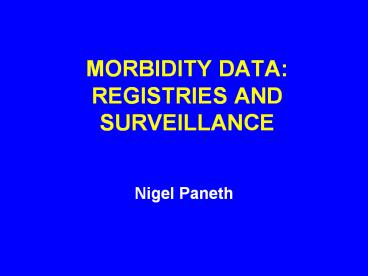MORBIDITY DATA: REGISTRIES AND SURVEILLANCE - PowerPoint PPT Presentation
Title:
MORBIDITY DATA: REGISTRIES AND SURVEILLANCE
Description:
MORBIDITY DATA: REGISTRIES AND SURVEILLANCE Nigel Paneth WHAT SHOULD BE UNDER SURVEILLANCE? Health events (diseases or exposures) with: HIGH FREQUENCY HIGH LEVEL OF ... – PowerPoint PPT presentation
Number of Views:125
Avg rating:3.0/5.0
Title: MORBIDITY DATA: REGISTRIES AND SURVEILLANCE
1
MORBIDITY DATA REGISTRIES AND SURVEILLANCE
- Nigel Paneth
2
WHAT SHOULD BE UNDER SURVEILLANCE?
- Health events (diseases or exposures) with
- HIGH FREQUENCY
- HIGH LEVEL OF SEVERITY
- HIGH LEVEL OF TRANSMISSIBILITY
- HIGH ECONOMIC COST
- HIGH POTENTIAL FOR PREVENTION
3
KINDS OF SURVEILLANCE
- 1. VITAL DATA
- 2. REGISTRIES
- 3. NOTIFIABLE DISEASES
- 4. SENTINEL HEALTH CARE SETTINGS
- 5. SENTINEL EVENTS
- 6. SPECIAL SURVEYS
4
Steps In Setting Up Surveillance
- 1. DETERMINE WHAT KIND OF SURVEILLANCE IS BEST
FOR THE CONDITION OF INTEREST. - 2. DEFINE CASENESS.
- 3. DEFINE THE POPULATION UNDER SURVEILLANCE.
5
- 4. DEVELOP DATA COLLECTION INSTRUMENTS.
- 5. DECIDE WHO THE INFORMATION GOES TO.
- 6. MONITOR THE SYSTEM
- FOR VALIDITY
- FOR USEFULNESS
6
Key Attributes Of Surveillance Programs
- 1. Nature of the event
- 2. Population under surveillance
- 3. Nature of the surveillance process
- 4. Continuity of the monitoring
- 5. To whom do the reports go?
7
1. NATURE OF THE EVENT UNDER SURVEILLANCE
- EXAMPLE
- a. Death Vital data
- b. Disease/condition
- based on screening newborn
-
genetic screening results - definitive diagnosis SEER cancer
registries
8
- 1. NATURE OF THE EVENT UNDER SURVEILLANCE.
(contd) - EXAMPLE
- c. exposure vaccine registries behavioral
risk factors - d. diagnostic test mammography surveillance
- e. animal disease bovine TB surveillance,
fox bat rabies
9
- 2. NATURE OF THE DENOMINATOR POPULATION
- A. EVERYONE IN A DEFINED SETTING
- EXAMPLE
- a. Universal Reportable diseases, vi
tal data - b. Everyone in a SEER geographic
area Registries or areas
10
- 2. NATURE OF THE DENOMINATOR POPULATION
(CONTD) - EXAMPLE
- c. Selected sub-sets sentinel of the
population practices for influenza - d. Special samples of Behavioral the
populations Risk factors, Health
Interview Survey
11
- 2. NATURE OF THE DENOMINATOR POPULATION
(CONTD) - B. CONDITIONAL ON A CHARACTERISTIC
- EXAMPLE
- a. requires exposure A-bomb survivors,
DES daughters - b. requires special LBW babies
cohort membership
12
- 2. NATURE OF THE DENOMINATOR POPULATION
(CONTD) - C. NO DENOMINATOR NEEDED
- EXAMPLE
- SENTINEL EVENTS
- (highly likely to maternal be
preventable) death to diphtheria
13
- 3. NATURE OF THE SURVEILLANCE PROCESS.
- EXAMPLE
- a. Active Reyes
- (we call them) syndrome
- b. Passive most registries
- (they call us)
14
- 4. CONTINUITY OF THE SURVEILLANCE
- EXAMPLE
- a. once-only community survey
- b. continuous registries monitoring
15
- 5. TO WHOM REPORTED?
- EXAMPLE
- a. state as per state law
- b. national 49 reportable diseases
- c. international plague, yellow fever,
cholera, etc.































